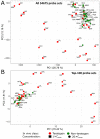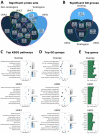High Accuracy Classification of Developmental Toxicants by In Vitro Tests of Human Neuroepithelial and Cardiomyoblast Differentiation
- PMID: 36359802
- PMCID: PMC9653768
- DOI: 10.3390/cells11213404
High Accuracy Classification of Developmental Toxicants by In Vitro Tests of Human Neuroepithelial and Cardiomyoblast Differentiation
Abstract
Human-relevant tests to predict developmental toxicity are urgently needed. A currently intensively studied approach makes use of differentiating human stem cells to measure chemically-induced deviations of the normal developmental program, as in a recent study based on cardiac differentiation (UKK2). Here, we (i) tested the performance of an assay modeling neuroepithelial differentiation (UKN1), and (ii) explored the benefit of combining assays (UKN1 and UKK2) that model different germ layers. Substance-induced cytotoxicity and genome-wide expression profiles of 23 teratogens and 16 non-teratogens at human-relevant concentrations were generated and used for statistical classification, resulting in accuracies of the UKN1 assay of 87-90%. A comparison to the UKK2 assay (accuracies of 90-92%) showed, in general, a high congruence in compound classification that may be explained by the fact that there was a high overlap of signaling pathways. Finally, the combination of both assays improved the prediction compared to each test alone, and reached accuracies of 92-95%. Although some compounds were misclassified by the individual tests, we conclude that UKN1 and UKK2 can be used for a reliable detection of teratogens in vitro, and that a combined analysis of tests that differentiate hiPSCs into different germ layers and cell types can even further improve the prediction of developmental toxicants.
Keywords: alternative testing strategies; developmental and reproductive toxicity; drug screening; gene expression; in vitro test; induced pluripotent stem cells; toxicogenomics; transcriptomics.
Conflict of interest statement
The authors declare no conflict of interest.
Figures







Similar articles
-
Definition of transcriptome-based indices for quantitative characterization of chemically disturbed stem cell development: introduction of the STOP-Toxukn and STOP-Toxukk tests.Arch Toxicol. 2017 Feb;91(2):839-864. doi: 10.1007/s00204-016-1741-8. Epub 2016 May 17. Arch Toxicol. 2017. PMID: 27188386 Free PMC article.
-
Classification of Developmental Toxicants in a Human iPSC Transcriptomics-Based Test.Chem Res Toxicol. 2022 May 16;35(5):760-773. doi: 10.1021/acs.chemrestox.1c00392. Epub 2022 Apr 13. Chem Res Toxicol. 2022. PMID: 35416653 Free PMC article.
-
A high-throughput screen for teratogens using human pluripotent stem cells.Toxicol Sci. 2014 Jan;137(1):76-90. doi: 10.1093/toxsci/kft239. Epub 2013 Oct 23. Toxicol Sci. 2014. PMID: 24154490
-
Embryonic stem cell test: stem cell use in predicting developmental cardiotoxicity and osteotoxicity.Methods Mol Biol. 2012;889:147-79. doi: 10.1007/978-1-61779-867-2_10. Methods Mol Biol. 2012. PMID: 22669664 Review.
-
Embryonic stem cells as an in vitro model for mutagenicity, cytotoxicity and embryotoxicity studies: present state and future prospects.Toxicol In Vitro. 2001 Dec;15(6):741-53. doi: 10.1016/s0887-2333(01)00074-1. Toxicol In Vitro. 2001. PMID: 11698176 Review.
Cited by
-
G × E interactions as a basis for toxicological uncertainty.Arch Toxicol. 2023 Jul;97(7):2035-2049. doi: 10.1007/s00204-023-03500-9. Epub 2023 Jun 1. Arch Toxicol. 2023. PMID: 37258688 Free PMC article.
References
Publication types
MeSH terms
Substances
LinkOut - more resources
Full Text Sources
Molecular Biology Databases

